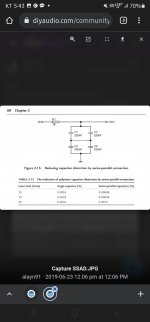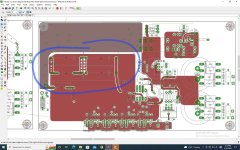I remember seeing a discussion of it here but cannot find it. Its basically 4 larger caps connected in such way to mimick the value of a single smaller cap while having much lower distortion. Does anyone have more info on this? Thanks
The series-parallel configuration halves the voltage on one cap, which is why it can reduce distortion. Typically non-linearities increase with voltage amplitude.Found it 🙂
You don't need 4 caps though, just 2 caps of double the value in series will work the same way.
Whenever connecting electrolytic caps in series you have the issue of the large tolerances they have though - don't expect them to share voltage precisely (and don't expect the leakage currents to match if they have DC across them - usually a resistor string is needed in this case to keep balance).
Can it still offer the same benefit by paralleling 2 caps of half the value?The series-parallel configuration halves the voltage on one cap, which is why it can reduce distortion. Typically non-linearities increase with voltage amplitude.
You don't need 4 caps though, just 2 caps of double the value in series will work the same way.
Whenever connecting electrolytic caps in series you have the issue of the large tolerances they have though - don't expect them to share voltage precisely (and don't expect the leakage currents to match if they have DC across them - usually a resistor string is needed in this case to keep balance).
You would connect them in series, to get half the signal voltage across each. But that would halve the uF value as well.
If you really have to use electrolytic capacitors, just use a single UES Nichicon instead.
They are very good, and don't need any tricks to work well.
https://www.nichicon.co.jp/english/products/pdfs/e-ues.pdf
If you really have to use electrolytic capacitors, just use a single UES Nichicon instead.
They are very good, and don't need any tricks to work well.
https://www.nichicon.co.jp/english/products/pdfs/e-ues.pdf
The series-parallel configuration halves the voltage on one cap, which is why it can reduce distortion. Typically non-linearities increase with voltage amplitude.
You don't need 4 caps though, just 2 caps of double the value in series will work the same way.
Distortion due to not entirely ohmic contacts might depend on the current. With series-parallel you halve both the voltage and the current, so distortion drops independently of whether it depends on the voltage or the current.
Hello,
RE: If you really have to use electrolytic capacitors -- Using good quality bipolar as you suggest lowers the distortion quite a bit. Also, using a higher voltage rated cap than needed lowers the distortion as well. So, a bipolar with a higher voltage rating is pretty good.
Believe it was Cycil Bateman who did the research that showed this.
Regards,
Greg
RE: If you really have to use electrolytic capacitors -- Using good quality bipolar as you suggest lowers the distortion quite a bit. Also, using a higher voltage rated cap than needed lowers the distortion as well. So, a bipolar with a higher voltage rating is pretty good.
Believe it was Cycil Bateman who did the research that showed this.
Regards,
Greg
Then use extended foil polypropylene or polystyrene capacitors. A higher voltage rating is better.
There are commercial amps which use series connected resistors in the nfb, so perhaps the effect is sufficient to justify the effort.
Hi wouldnt this trick work the same with resistors too? 2 r in series+ 2 in parallel.
Short answer: it also works with resistors.
Long answer: the distortion of a low temperature coefficient metal film resistor operated far below its power rating is already so small that it is very hard to measure. If you should want to reduce it further, you could indeed use series-parallel combinations.
For a feedback network that sets a dimensionless gain of which the value is a rational number, a voltage gain of 23.5 for example, you could try using a series string of "equal" resistors. For example, 47 resistors of the same type and value in series with a feedback tap after two resistors. Hopefully the distortion of the resistors will then cancel to some extent, as they all see equally large signals.
Ive started working on a layout with this string resistor 'trick' implemented. Its a 3x gain so i only need 4 equal pieces. However the visual intuition tells me that the increased loop area from this trick might negate its mechanical benefit in terms of overall performance.
In addition to the increased inductance, wouldnt the bigger loop area mean more rfi/emi vulnerability?
Ill post some pics of the pcb next time im using eagle
In addition to the increased inductance, wouldnt the bigger loop area mean more rfi/emi vulnerability?
Ill post some pics of the pcb next time im using eagle
This has been promoted by AP founder/designer Bruce Hofer. The effect is that the voltage- and temperature coefficients across the feedback string cancel because they all see the same voltage and temp changes, as you noted.Short answer: it also works with resistors.
Long answer: the distortion of a low temperature coefficient metal film resistor operated far below its power rating is already so small that it is very hard to measure. If you should want to reduce it further, you could indeed use series-parallel combinations.
For a feedback network that sets a dimensionless gain of which the value is a rational number, a voltage gain of 23.5 for example, you could try using a series string of "equal" resistors. For example, 47 resistors of the same type and value in series with a feedback tap after two resistors. Hopefully the distortion of the resistors will then cancel to some extent, as they all see equally large signals.
But it's really needed only when measuring extremely low distortions, like below -140dB.
Jan
Yes, it would. Can you make a twisted layout (figure of 8) where one loop compensates the other?In addition to the increased inductance, wouldnt the bigger loop area mean more rfi/emi vulnerability?
Ill post some pics of the pcb next time im using eagle
In a class-B or class-AB amplifier, magnetic coupling from the output stage currents to the signal path can cause extra even-order distortion. For an amplifier driving 8 ohm or 4 ohm loudspeakers, unless you have an exceptionally good layout, it probably contributes more to distortion than resistor distortion (but it is even-order while resistor momentary temperature variations cause odd-order distortion).
Twisted layout such as the feedback r's overlapping the output trace? I might be able to.Yes, it would. Can you make a twisted layout (figure of 8) where one loop compensates the other?
In a class-B or class-AB amplifier, magnetic coupling from the output stage currents to the signal path can cause extra even-order distortion. For an amplifier driving 8 ohm or 4 ohm loudspeakers, unless you have an exceptionally good layout, it probably contributes more to distortion than resistor distortion (but it is even-order while resistor momentary temperature variations cause odd-order distortion).
Heres another idea. Quad input caps, for the composite amp im working on. The cap quality will be better but once again, rfi susceptability becomes more obvious cuz now its a 4x bigger antennae. One could wrap them and ground them in copper tape tho.
Attachments
- Home
- Design & Build
- Parts
- Quad caps for less distortion?

